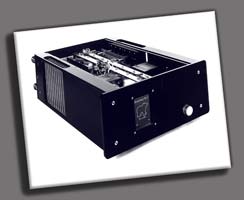 Symphony No.1 Amplifiers
(4.04)
Symphony No.1 Amplifiers
(4.04)
BEAR Labs Symphony No.1 Amplifiers are more than just big,
more than just
powerful, more than just another amplifier. Despite the hype and controversy
regarding the audibility of amplifiers, or the audibility of subtle
differences,
there is little doubt that The Symphony No.1 series of amplifiers is both
audibly
and technically outstanding. It does make a difference!

The Symphony No.1 Amplifier originally grew out of
a quest for an amplifier to run
my ESL speakers and not just meet, but to exceed their sonic resolution.
At the time
I began this quest, I would have been happy enough to
buy an existing commercial amplifier.
If I could have found one that met my criteria. I
could not find even one.
Although there are many amplifier designs,
both tube and solid state that have
many things to commend them, I was unable
to find one unit that embodied all
the elements of what I believed a truly
outstanding amplifier must have. Nor
could I find one that met my sonic expectations!
It was necessary to build that amplifier. Now, you
can own one too!
(Needless to say, measurements are not the sole criteria.)
The Symphony No.1 Amplifier measures very
well:
Frequency response: DC to 250 kHz.
Power output: >180watts into 8 ohms - OVER
800 watts into a low Z reactive load!
THD: < 0.0025% @ 1 kHz / 0.0065% @10kHz.
Slew Rate: 75v/usec
Rise Time: 1 usec, 60v p-p square wave
Voltage gain: 26 dB
High bias class AB
Output devices: Mosfet, (12) per channel
Weight: 128lbs.
This only tells part of the story. Here's more of the story!
The Symphony No.1 is built using >2.5kva
of transformers. No less than 4 stacked
toroidal types are used to achieve this rating. That
means there is a >2500 watt
power source, powering dual 180 watt nominal channels!!
Keep this in mind: as the load impedance lowers,
and as the phase angle of the load shifts,
the demands upon an amplifier increase. Include complex musical passages (choral
passages,
horn sections, guitars on top of vocals for example) into this equation. Under
these strenuous
conditions often one can detect variations in
the sound quality as well as loss of
spatial dimension & resolution.
If
one applies a 4 ohm load, the power tries to double, to 360 watts per channel, or
720 watts RMS total, in this example. The power supply must not
flinch
in the face of this demand. The 2.5kva transformers are unphased by this demand.
This amplifier is loafing! That is what you need.
Read
on...
Then the supply is filtered by 500,000 ufd
(that's half a FARAD) of filter caps. The
DC is supplied to this gigantic power reservoir
by a full wave bridge consisting of
discrete 140 ampere rated HEXFRED (soft
recovery) power rectifiers. These in turn
are linked to the filter bank by solid copper,
1/4" thick x 1" wide, buss bars.
An amplifier is only as good as its power
supply.
When you listen to an amplifier in effect you are
listening to the power supply being
hooked to your speakers! This power system can produce and supply copious
amounts
of clean, clear HIGH CURRENT power instantly upon demand. Few amplifiers really
can make this claim.
Power is supplied to the amplifier
modules by stranded 10 ga. Silver Plated Copper,
"teflon" insulated wire.
The amplifier itself is DC coupled - but
NO SERVO amps are used to maintain the
DC balance! The amp is so well balanced
that none are needed, and no relay is needed
to prevent turn on or turn off thumps!!
However, a turn ON soft start system is provided
to 'cushion' the turn on current draw from
the wall. (otherwise your home circuit breaker
could trip). DC coupled circuitry also means
that there are NO capacitors in the signal
path.
No matter what, capacitors in the signal path add
some degree of coloration. Servo
controlled amps inevitably have a sort of coloration.
Other than the soft start system, there are
no other limiting or protection devices
added into the amplifier.
This is not an
amplifier for those who are not prepared for the ultimate in performance.
It is like
the difference between owning a luxury automobile vs. an ultra high performance,
hand built
car - like a race car or perhaps a Lamborgini, Ferrari or similar no-holds barred
vehicle.
The only limit is the driver and the driver's skill! Here, the same is true, the limit
is the quality of your system, your source, and you as the owner.
The amplifier modules each use 12 hand selected
and precision matched output devices.
The output devices are Mosfets. They are
precision matched to avoid the need to use
source resistors in order to balance the
currents between each bank of 6 Mosfets. If
randomly selected Mosfets were used without
resistors, one or two Mosfets would
'hog' current, and overheat. There is potential
for both non-linear operation and actual
device failure in that case.
As far as I know, this is the only amplifier
not to use degeneration resistors on each
output Mosfet or Transistor! There are none in the circuit. How is this
possible? The
"trick" is to use extremely careful matching of devices, culled out of
large batches in
order to truly achieve virtually identically matched devices. No one else does
this.
Everyone else relies on resistive degeneration and loop feedback to
"correct" after
the fact.
Mosfets offer two distinct advantages over
the usual bipolar transistors: 1) a negative
temperature coefficient, 2) a soft clipping
characteristic. Bipolar transistors when
they get hot tend to simply want to get
hotter - and burn up. When bipolar transistors
are driven into clipping, they make very
nasty sounds. Mosfets effectively avoid both of
these problems.
If you've heard about "Mosfet haze" you've
been mis-informed. That sound is due to poor
practices elsewhere in the amplifier - not
due to Mosfets at all.
A few other points... The amplifier is constructed
using Stainless Steel hardware thoughout.
It will not rust or corrode. Numerous optional
finishes and choices in materials are available.
This amplifier is
custom built, individually
commissioned and is a reserved
production item. To be included when production is scheduled,
reservations
are required. Please Email BEAR LABS to get more information, or to place
your order.

 Symphony No.1 Amplifiers
(4.04)
Symphony No.1 Amplifiers
(4.04)